This is the World Cup ball — in 3D and in its actual size. These are interactive graphics and non-digital interactive graphics. The history of the 32 competing teams through data sets assembled in three-dimensional paper pyramids. Each spread of the team profile contains a template that readers can cut, paste, and piece together to form the ball. This is dedicated to those who want to go deeper into statistical analysis or to those who share the passion for fun and interactivity
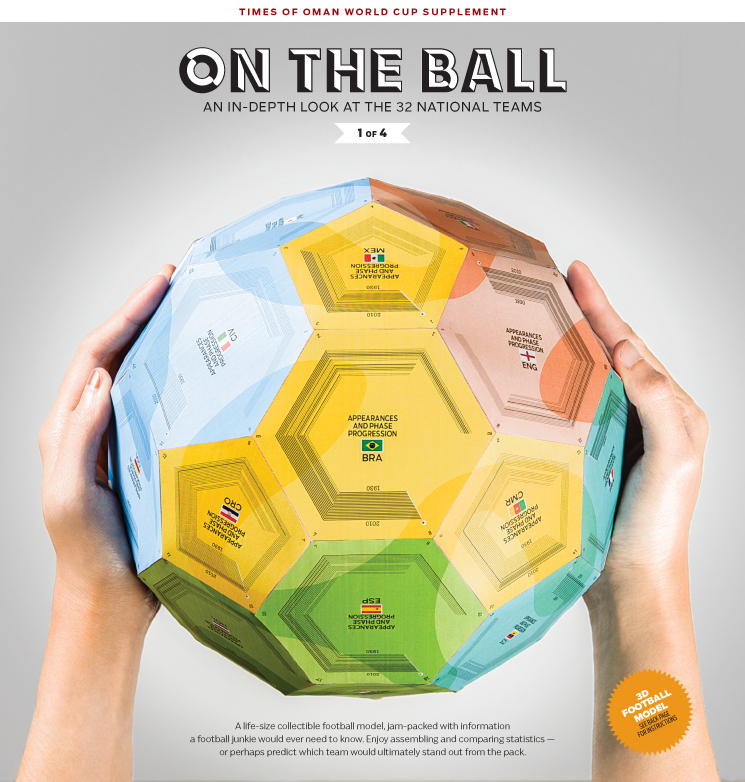
This is the prototype which was assembled by Muthita Torteeka and Amornsri Anutrakulchai. The cover was designed by Ali Jani, photography by Cio Datan and hand model: Amornsri Anutrakulchai


128 pages in 1.6 seconds
Two simultaneous supplements were published in English (Times of Oman) and Arabic (Al Shabiba). Here is a fast view of the 32 teams in both languages:
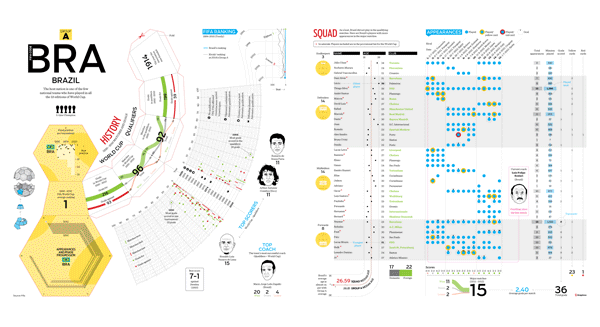
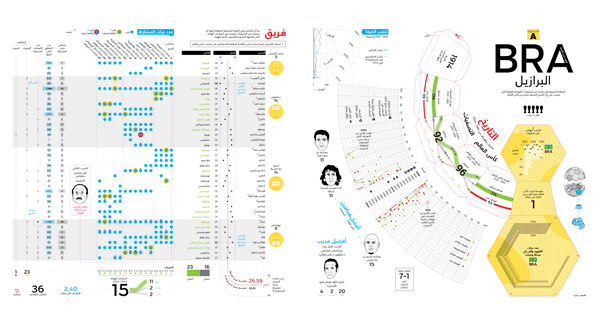
The creative process
The very beginning
I started to think about this project in December, considering doing a graphic blanket, first with 100 spreads, then 25, and then later with 16:

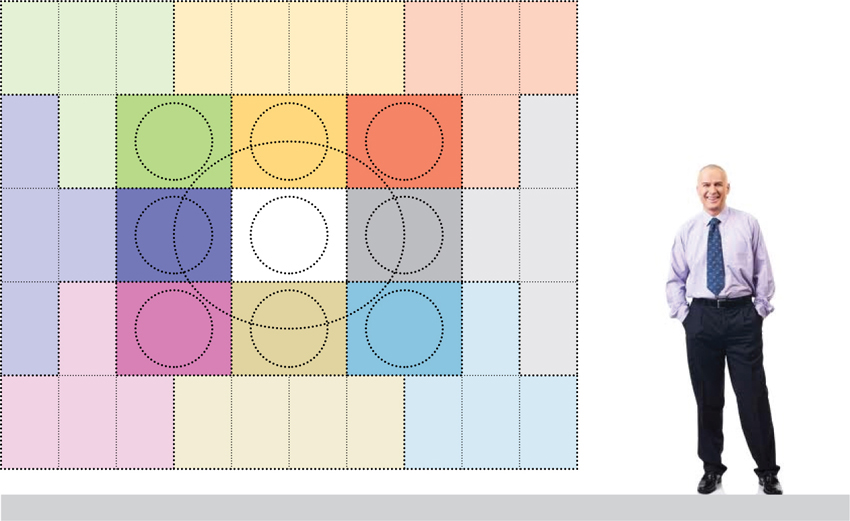
Later I wanted one World Cup Squad on one page, featuring the squad’s key player illustration with a rectangular statistical matrix. The interactivity factor was in my mind from the beginning: I wanted to give the readers the opportunity to compare the squad’s matrices of one single World Cup group by cutting and putting together the pages
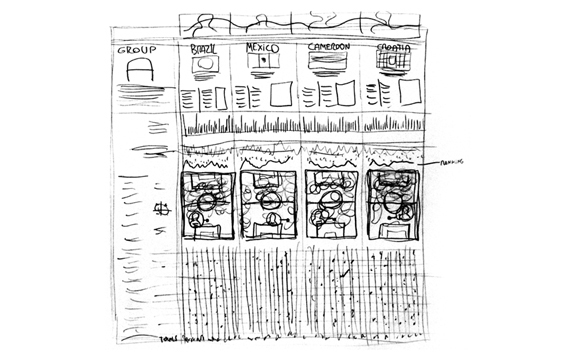

Neymar sketch by Lucille Umali
That formula was perfect for me until was decided that the format needed to be changed from a spreadsheet to a tabloid. So I’d break the vertical single page into a tabloid double-page:

This design still worked for me (One page for the nation’s history in World Cups on the left page and the current squad’s statistics on the right), but not at all, the piece still lacked the desired hook!
The inception of the ball
How I’d found the ball shape was in some way lackadaisical. In the beginning, I was looking for a 32-side volume and I found the icosidodecahedron, which is composed of pentagons and triangles but there is too much difference between those two shapes. Later I was looking at the truncated dodecahedron, both the difference in size between both shapes was higher

Then I found the truncated icosahedron. It never crossed in my mind the idea of a football, I just wanted something that can match with the 32 teams of the tournament, something with 32 sides, so when I saw the truncated icosahedron I never expect that will have 32 sides! It was perfect! A 32-side polyhedron with regular sides and as well a football!!

Then, after that, the challenge was to discover how to assemble it. I was considering a ball in two paper parts —not in 32 parts as the final version was published— but was very unstable. So I started to look on the web for possible existing paper models. I found some very sophisticated ones and more based on origami but I was looking for something easier for the readers to assemble, so that was when I decided to create my own puzzle
Creating the puzzle
There is a way to create this ball with 32 pyramids. The problem in paper modeling with the cones and pyramids is the tip, to handle properly the tip is very difficult —I remember all the headaches that I had in 8th grade with that— so I’d decide to cut the pyramids’ tips and turn them into truncated pyramids
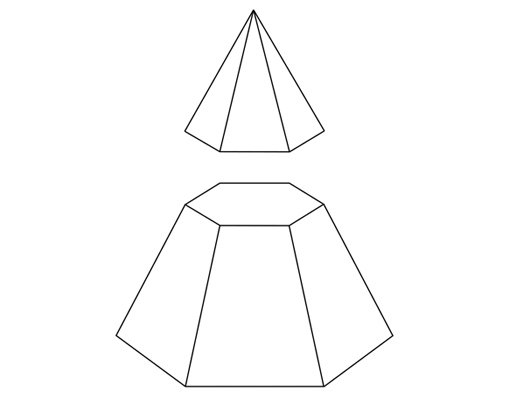
That creates a hollow ball, mmm —I said to myself, interesting, like the hollow Earth theory!—

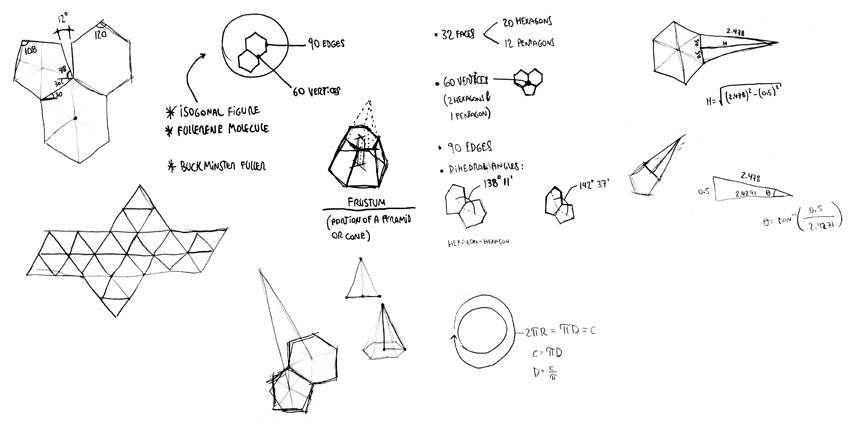
I decided on the height (h) for each of the 32 frustums —Is how it’s called in geometry— based on two constraints, the first was the space in the page because I was planning to include more information outside the cutting area; the second was that the higher the pyramid is, the lesser flexibility you have when you are pasting all the pieces together

The first mock-up

I printed 32 generic templates that the team cut and assembled. After I got all the 32 assembled frustums I proceeded to assemble the ball. At halfway I discovered that better to assemble the ball into two halves, two hollow hemispheres. With a few imperfections but acceptable, IT WORKS!
The Brazuca pattern
The pattern of the 2014 World Cup official ball, called Brazuca, was inspired by the Amazon River meanders. The first was to superimpose and match the Brazuca pattern into the truncated icosahedron, starting from the conjunction of three Brazuca helices.


The difficulty to replicate the Brazuca path resides in the fact that is complementary —If you modify one figure, at the same time you are modifying the adjunct figure:

After many trial and error processes I found that I needed to define only three different faces to emulate the Brazuca look: two hexagons and one pentagon:

Positioning the 32 countries
Once the three basic faces of the ball were ready, the next step was to decide the position of each country. I found several arrangements on the web...


...But I chose one that allow me to divide the 32 into groups of 4 teams, like the World cup groups:

I looked to assign hexagons to the most historical countries in World Cup because hexagons are more dominant in size than pentagons but was impossible because there are a total of 12 hexagons and 20 pentagons in a fixed interposition: two hexagons connect always with one pentagon. That combination didn’t allow it. So in the end I placed the countries by group, that was my priority

Numbers must be in each corner, that’s the main guide to the reader/player
Face content
I tried many contents and many chart styles for all the sides but for the lateral sides I decided on symmetrical Sankey diagrams because the totals can be broken out to the sides, so you can compare one country’s side with the opposite side of another country of the same group to know who is stronger

Preliminary design for lateral faces of the truncated pyramid

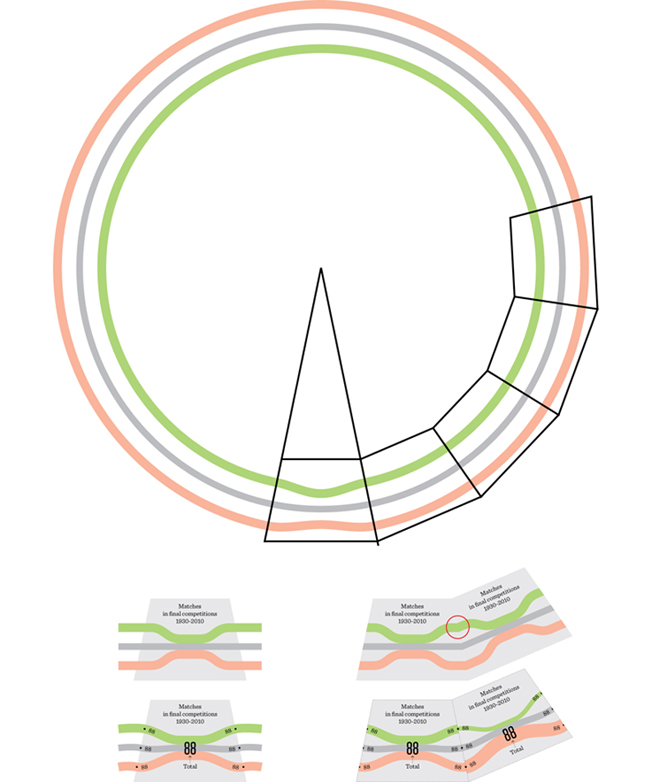
I was stuck in the bases. I’d created a kind of parallel shape in the bottom one but I was not happy with it, the evolution cannot be noticed...


...So I asked my mate Marcelo Duhalde to help me. In a couple of days he returned to me with the solution for the bottom base chart and a proposal for the upper base chart, two insane charts:

I applied it instantly
Checking the size
Some calculations need to be done to be sure the ball will be in actual size (Diametre=22cm) and to check that the templates will fit on a tabloid page

With the ball concept, the new page design
With a truncated pyramid inserted in the history page, I started to test many options. At the beginning I have the option to have a ball in actual size and also in a bit bigger scale, notice the size difference between both green templates:

Later I decided to build around the pyramid template:

Scattered history
In the beginning I created the radial grid following parallel around the pyramid rotational centre:

Page design evolution:
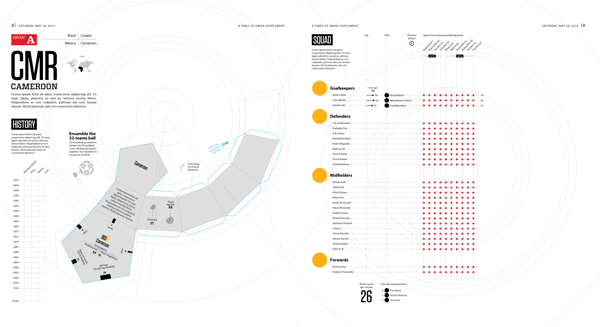
The production
The database
I had very high expectations about the databases so a created a very complex model to be filled in order to use that same database to produce additional graphics during the World Cup, like attendance history, local-visitor factor, etc. but later we discovered that was too ambitious and we didn’t have enough time, so we kept simpler databases. But still, with less data the databases were huge. Marcelo Duhalde was assigned to study and produce the both main databases: The statistics for the past 19 World Cups and the 2014 qualifiers.
Illustrations

The illustrations of all the players and coaches were done by our senior artists: Isidore Carloman, Lucille Umali, Winie Ariany and Marcelo Duhalde
Collaboration of the whole design department!
Collaboration of the whole design department!
World Cup was very close and the database was still not finished, so the design director asked the design team to come to work on the weekend and all of them came! That weekend each designer was assigned one country page (database+page). It was a good exercise for them and a good help for me...
... And then they were 16:
Ismael Sandiego
Waleed Rabin
World Cup was very close and the database was still not finished, so the design director asked the design team to come to work on the weekend and all of them came! That weekend each designer was assigned one country page (database+page). It was a good exercise for them and a good help for me...
... And then they were 16:
Ismael Sandiego
Waleed Rabin

During the pizza-break
Line Production
In order to bust our production speed we did separate the work into production lines:

Lateral faces before being rotated and grouped:

Coaches:
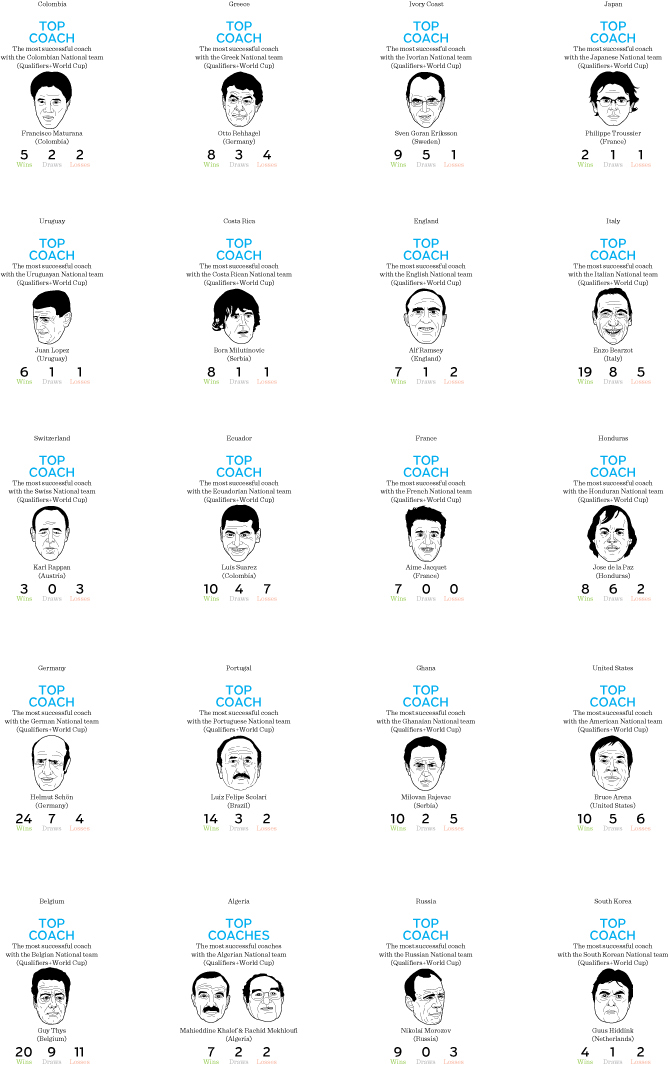
Fifa Ranking:
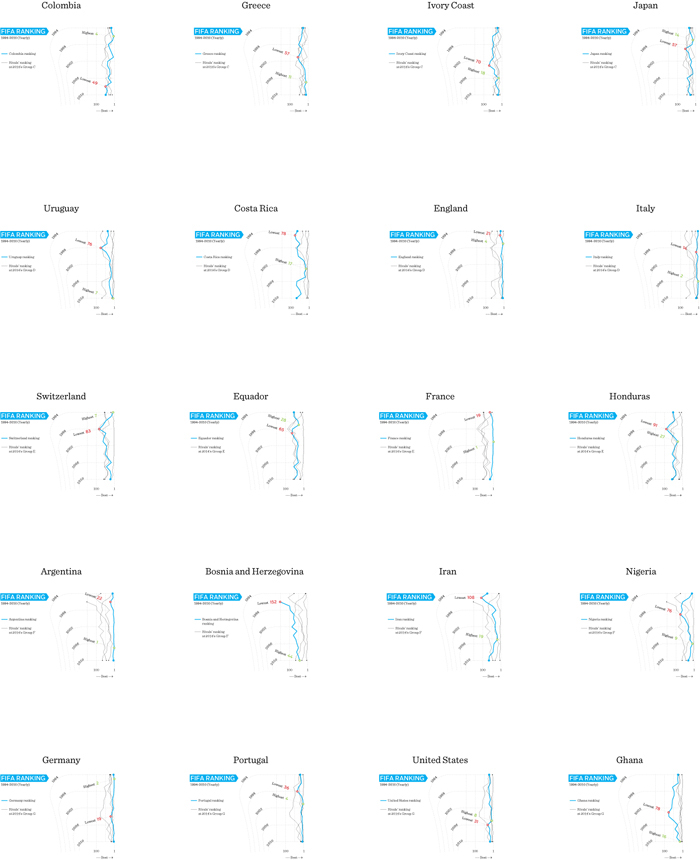
Appearances and phase progression
We had many discussions with Marcelo and the Design Director, Adonis Durado about the title for this face. In the end, Adonis came up with the final title: "Appearances and phase progression":

Core Working
From March to May this project consumed most of my time and the time of my colleague, Marcelo "Chilean Jewel" Duhalde, the magician-visualizer from Osorno, Chile, aka "Barbazoom" or "El Joya":

The Prototype
Once all the 32 double pages were finished, I printed it and with the big help of the real industrial designers, Amornsri Anutrakulchai (Amor) and Muthita Torteeka (Pang), who cut and gummed all the pieces with a near-perfect-grade precision, WE GOT OUR FIRST BALL!



Instructional video
Another version
Once the English version was done, with all of us very tired, we started to work in the Arabic one! The both editors Khaled Taha and Ahmed Badawy translated in record time the whole project into Arabic. Ali Jani did help us to check one by one all the Arabic pages with an attention to detail that you do not see every day, thank you, Ali!
Last review

Printing at last!


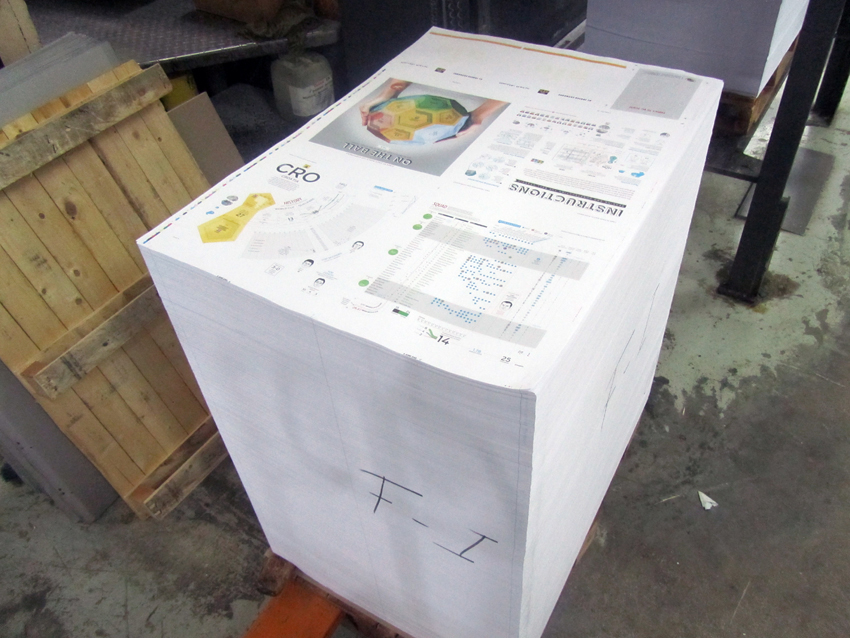
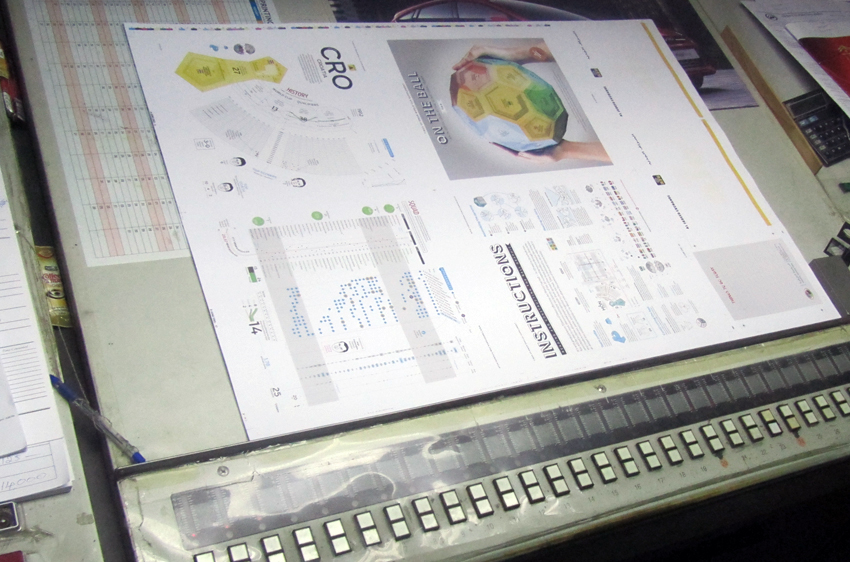
Here are some reduced samples:


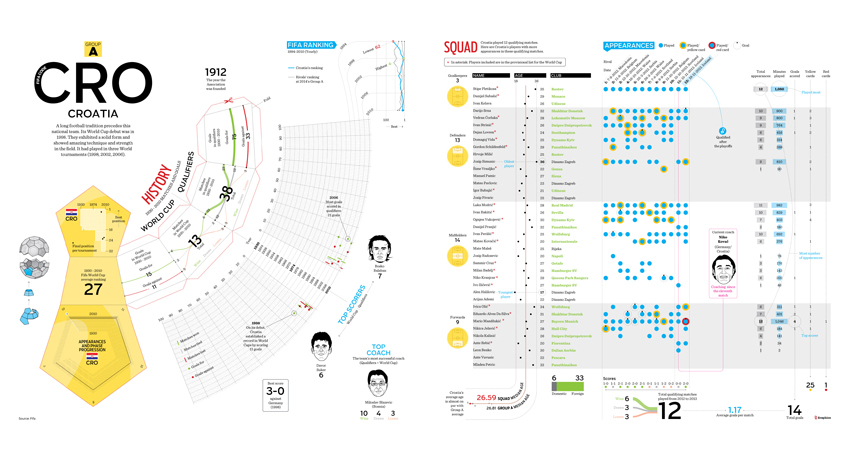



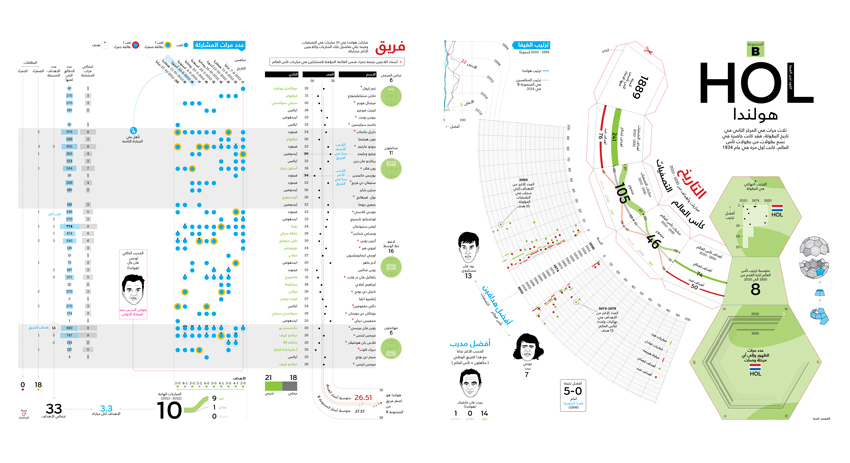
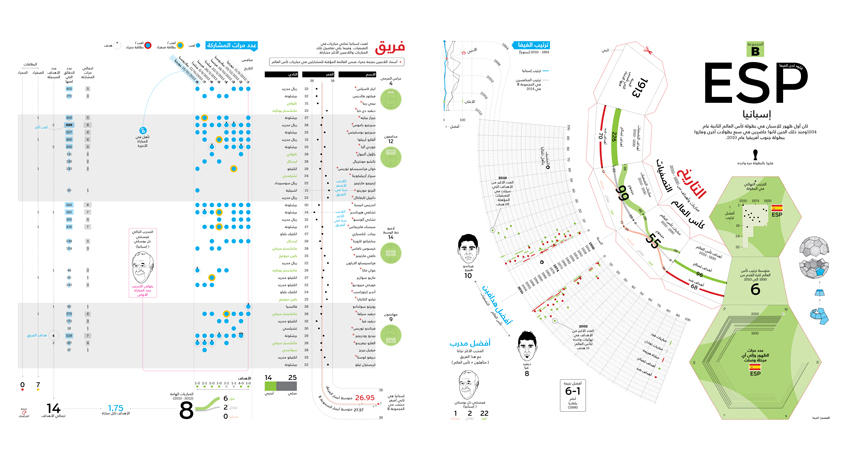
ONE MONTH LATER: THE INNER BALL
The (shell) ball was published at the beginning of the World Cup. Once the Final match finished, we published a complementary inner ball with the results of the 2014 World Cup. Then, we gave a whole set!

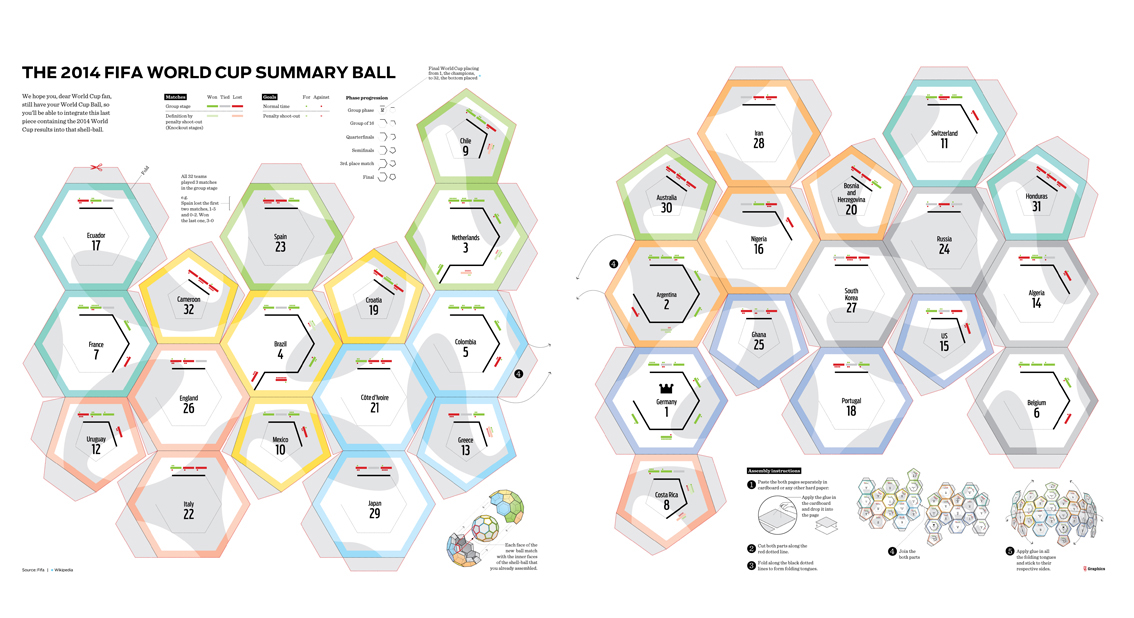

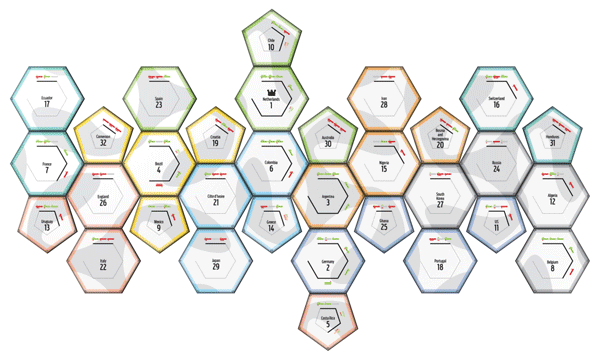

With the inner ball, this how it looks the entire project
PAPER STILL LIVES!


